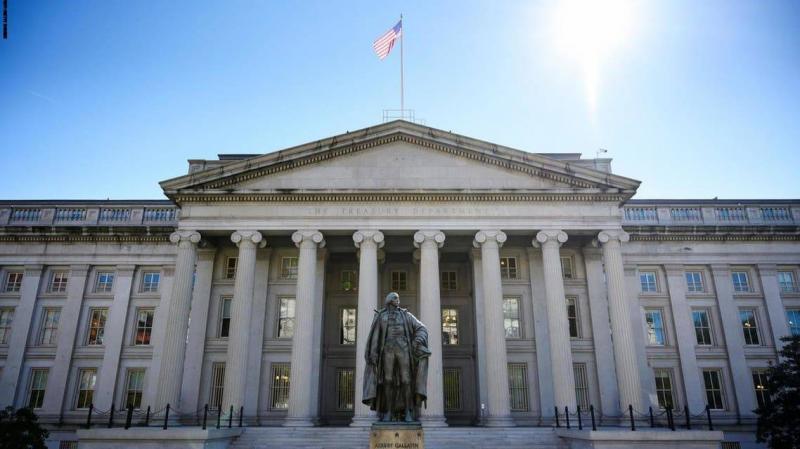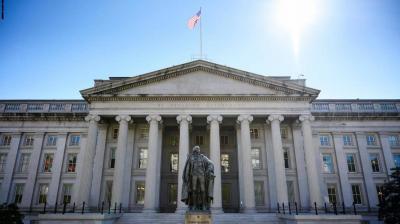Under the title "What Would Happen If the United States Defaulted on Its Debts?", Al Arabiya published a report highlighting that as Washington nears a "government shutdown" by midnight Thursday, a term known when a legislative body fails to agree on funding for government program budgets for the upcoming fiscal year, the current issues surrounding the U.S. debt ceiling are becoming significant. September 30 marks the end of the federal government's fiscal year and the deadline for Congress to pass a funding measure. The debt ceiling, the maximum amount of money allowed by lawmakers for the U.S. Treasury to borrow, must be suspended or raised, especially since by mid-October, the United States may likely default on its debts.
Currently, U.S. sovereign debt is generally considered the safest and most liquid asset to hold in the world, with various types of financial products and market operations linked to the orderly performance of the nearly $21 trillion treasury market. However, following several years of vertical fluctuations that have turned previously unimaginable scenarios into reality, some Washington and Wall Street experts are preparing for the worst-case scenario.
Ben Colton, the director of research at Beacon Policy Advisors, stated: "I see it as a very unlikely possibility, and if it happens, it turns a manufactured political crisis into an economic crisis. The complete faith and credit of the United States would no longer be intact."
**Will the U.S. Run Out of Money?**
In a research memo published on September 22, analyst Joseph Abate at Barclays noted additional uncertainty regarding the debt ceiling now as it coincides with a funding package that Congress needs to approve. Furthermore, changes brought by the pandemic have made it increasingly difficult to assess the payment status and expected flows from the Treasury Department. While no one can accurately answer when U.S. Treasury funds will run out, Barclays' best estimate is October 29, although Abate wrote, "the confidence window around that date is likely to remain rather broad." Meanwhile, Mark Zandi, chief economist at Moody's Analytics, pinpointed the ominous day as October 20, while Colton from Beacon believes that markets will begin to feel the strain by mid-October.
The idea of a default in the United States remains so contradictory that the reaction in financial markets is not the only unknown. The current standoff in Washington has also raised significant questions about the infrastructure of financial systems. Rob Tomie, managing director of capital markets and assistant general counsel at SIFMA, remarked: "We do not believe, nor does the market, that it is a plausible scenario." However, it would present a real problem scenario for the system in general and for operations and settlements specifically.
**Settlement Issues**
SIFMA (Securities Industry and Financial Markets Association), which deals with how securities like sovereign bonds are traded and settled, identified two potential scenarios: If the Treasury Department knows it will default, it would be best to announce it at least a day in advance. This would allow changing the due dates of the affected bonds: for instance, those due on Monday would shift to Tuesday, and those due on Tuesday to Wednesday, and so on. These revisions would happen day by day.
While this seems relatively organized, it still leaves many unknowns. For one, it could divide the Treasury bond and bill market into those that are set off naturally and those that have their due dates delineated, according to SIFMA's comments to MarketWatch, which Al Arabiya reviewed. This implies a substantial amount of uncertainty around pricing and what it signifies for all final securities linked to Treasury bill rates.
In the second scenario, where the U.S. Treasury cannot provide prior warning of the default, the situation would be much messier, described by SIFMA as a "real problem scenario." Curiously, the securities that the U.S. Treasury would default on might simply vanish from the system. This is because if a bond were due – and payable – on a certain day, the trading system was designed on this premise without exception, leading it to erase those bonds from the system.
If this occurred, the records of bondholders would be referred back to the day before the maturity date to ascertain who was entitled to receive their money; however, it is also likely that the Treasury would pay some additional interest to fulfill the rights of bondholders for the settlement day.
Many analysts, including Zandi, believe that some level of panic in the financial markets is quite likely, a scenario reminiscent of the day Congress initially failed to pass the Troubled Asset Relief Program aimed at addressing the financial crisis. However, as Colton said, "even if only for a moment, the lost credibility could lead to a permanent increase in the yield on 10-year Treasury bonds by about 1.539%, which has cascading effects on financial markets around the globe."
Historically, Congress was last close to not raising the debt ceiling in 2011 and 2013, as Moody's found that "the increasing uncertainty at that time led to reduced business investment and hiring, weighing on GDP growth." In its analysis, it noted that without this uncertainty, by mid-2015, real GDP would have been about $180 billion higher, or more than 1%; there could have been 1.2 million additional jobs; and the unemployment rate could have been 0.7 percentage points lower.




